
When Marine Corps Major General Clay Comfort retired in 1987, he told friends that one of his post-retirement goals was to kill the V-22 Osprey program. Comfort understood the flaws in the tiltrotor design, having earned a master of science degree in aeronautical engineering from the Naval Postgraduate School. He also served as Deputy Chief for Aviation at Headquarters Marine Corps when the V-22 tiltrotor idea was pitched, and later served as Commanding General of the 3rd Marine Aircraft Wing.
General Comfort's quiet attempt to save the Marine Corps from the V-22 failed when he passed away in 2004. In a final effort, he sent G2mil a copy of a 2003 confidential study from the Institute for Defense Analysis (IDA). This is an organization used by the Pentagon to provide independent expert analysis. This Marine Corps funded report declared that the V-22 remained fundamentally unsafe, despite minor modifications in recent years. The V-22 program has continued despite General Comfort's efforts, and despite the IDA report that was posted for all to see at G2mil. There are several other serious safety problems with the V-22 that report did not address:
The Plastic Airframe is Flammable
Last year, one of Boeing's top engineers, Vince Weldon, appeared on "Dan Rather Reports" to proclaim that Boeing's newest aircraft would prove unsafe. This 787 "Dreamliner" passenger jet will have an all composite (i.e. plastic) airframe to save weight. This material has been used successfully in fighter aircraft to reduce weight and improve performance. However, composite material is flammable and produces toxic fumes, but fighter pilots have ejection seats to instantly leave a burning aircraft. Weldon worries that a small fire on a passenger jet could ignite the airframe, and the fire would spread rapidly when fed by air flowing outside at hundreds of miles an hour. He said that sections of a composite aircraft will shatter during a crash landing, killing passengers and allowing outside air to rapidly feed a fire.
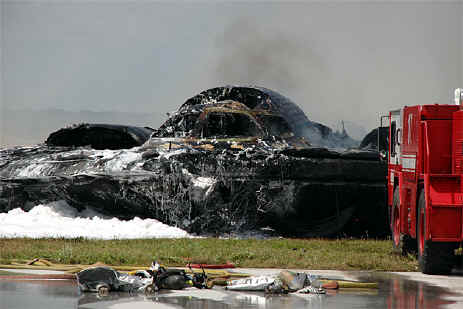 An example occurred this year when a B-2 bomber crash
landed in Guam. During take-off, its computer became
confused by faulty sensor readings, and it banked too sharply causing a wing to
strike the ground. The aircraft leveled-off and slid along the grass at the end
of the runway. Actual damage was minor, but a small fire ignited the composite airframe. Although firefighting crews arrived
within minutes, the fire
had spread rapidly and ruined the B-2. (left)
An example occurred this year when a B-2 bomber crash
landed in Guam. During take-off, its computer became
confused by faulty sensor readings, and it banked too sharply causing a wing to
strike the ground. The aircraft leveled-off and slid along the grass at the end
of the runway. Actual damage was minor, but a small fire ignited the composite airframe. Although firefighting crews arrived
within minutes, the fire
had spread rapidly and ruined the B-2. (left)
The V-22 also has a composite/plastic airframe, rather than the traditional aluminum and fiberglass materials, which are heavier and shatterproof. If Boeing's Weldon thinks composites are too dangerous for commercial passenger aircraft, he must think using them for military assault transport aircraft insane. The Navy Safety Center instructs crash-rescue teams not to attempt to extinguish burning composite aircraft since the smoke is toxic.
Heavy machine guns often fire tracer rounds. Should one become lodged in a V-22, it may ignite the aircraft. Exploding anti-aircraft munitions and even RPGs are likely to ignite a V-22. Oil and hydraulics leaks have caused dozens of fires on V-22s. In at least two cases, they have ignited the composite nacelle and started a fire that ruined the engine and wing. The pilots were lucky to be near the ground in these incidents and landed quickly. The V-22 crash near Quantico was caused by a fire that quickly burned through the composite wing. Pictures of the two V-22 crash sites in 2000 show little debris as the plastic aircraft burned up. Even a minor fire may cause catastrophic damage since the V-22's composite fuselage and wing is cast as one piece and cannot be repaired. At least three V-22s have been quietly scrapped because of damage to a wing.
The Fuselage is not Crashworthy
Tiltrotors perform so poorly that dozens of compromises were made to shed weight on the V-22, like using a composite airframe and composite parts. Original plans called for strong Kevlar flooring to provide ballistic protection and support combat vehicles, but that was dropped. That decision along with the composite fuselage caused it fall short of Navy safety standards, which require the fuselage to survive the impact of a crash landing without breaking apart or collapsing. The film "Blackhawk Down" shows Blackhawk helicopters crash landing without disintegrating or collapsing.
As a result, Bell-Boeing invented the idea of "mass shedding." As a V-22 makes a controlled crash, pilots must land like an airplane on a runway and keep the proprotors forward in the airplane mode. This will cause the large proprotors to strike the ground first, which is supposed to cause both wings to break-off along with the heavy engines. This sheds much weight, so Bell-Boeing argues the aircraft is much lighter when the fuselage strikes the ground two seconds later. Their calculations show this allows the V-22 to meet the Navy standard.
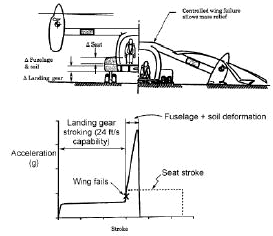 This has never been demonstrated. It is only
possible if the V-22 is in the airplane mode and if an open area is available to
land. This is a difficult challenge for pilots since they always tilt the proprotors
upward as they land, and will instinctively want to do that to reduce airspeed,
especially if they have some engine power. Moreover, V-22s are most likely to be
hit by ground fire while slowly landing or taking off in the helicopter mode with rotors up. Since a V-22 needs
2000 feet of altitude to convert to the airplane mode as it falls, it will
hit the
ground with no mass shedding to cheat Navy standards.
This has never been demonstrated. It is only
possible if the V-22 is in the airplane mode and if an open area is available to
land. This is a difficult challenge for pilots since they always tilt the proprotors
upward as they land, and will instinctively want to do that to reduce airspeed,
especially if they have some engine power. Moreover, V-22s are most likely to be
hit by ground fire while slowly landing or taking off in the helicopter mode with rotors up. Since a V-22 needs
2000 feet of altitude to convert to the airplane mode as it falls, it will
hit the
ground with no mass shedding to cheat Navy standards.
In addition, an airplane landing requires a large, flat open area, so "mass shedding" is impossible in urban areas, mountains, and forests. Finally, NATOPS states that landing gear must remain retracted if landing on soil, lest it dig in and flip the aircraft on its backside. As a result, the mass shedding required to meet Navy safety standards can only occur if the V-22 lands on a long, hard runway and both wings break off cleanly. If it must crash land anywhere else, the fuselage is likely to break apart and burn.
Another problem is the V-22 has short span, thick wings that give higher drag compared to airplanes. This results in an awful glide slope of 1 to 4, i.e. it loses one foot of altitude for every 4 feet of forward movement. Airplanes have larger wings and glide slopes in the high teens. As a result, if a V-22 is forced down from a loss or lack of power, it will descend three times faster, giving pilots less time to select a landing site, and the pilots must flare much more aggressively to make a good landing.
A related issue is the late effort to install crashworthy seats. The first 120 V-22s were delivered with lighter seats that failed Navy safety tests years earlier. Bell-Boeing was not held to account and new seats are being purchased and installed at government expense. This is pointless because tests also showed that the seats popped off the V-22's lightweight fuselage, then smashed into the lightweight flooring. The Bell-Boeing team looked for solutions, but any refit would require rebuilding the aircraft and adding a couple thousand pounds of reinforcement, so it never happened.
Details on this problem can be found in a 2005 NAVAIR report (pdf). A March 2008 GAO report (pdf) also mentions this serious safety issue and states that production V-22s are still accepted with deviations and waivers. Bell-Boeing could prove the V-22 is crashworthy by using one of the dozens of retired V-22s sitting hangars for a standard FAA drop test. However, it is likely to shatter as seats pop off and strapped-in dummies are ejected or crush each other. This would prove embarrassing and set the stage for a civil lawsuit disaster, so this will never occur.
NATOPS is Hyped
Many pilots are shocked to learn that the charts in the V-22 Naval Air Training and Operating Procedures Standardization (NATOPS) are inaccurate. This is the pilot users manual relied upon for safe operation. The demonstrated performance of V-22 was so poor that Bell-Boeing executives decided to insert old optimistic "projected" performance data into NATOPS' range and payload charts. New V-22 pilots learn from others that NATOPS is hyped, but this still endangers flight crews who must learn the V-22's limitations through experience and guesswork.
Dangerous Hydraulics System
One of the original concerns about the V-22 design was the side-by-side rotor design. As the NATOPS notes: "Because of the inherent instability of the tilt-rotor..." the V-22 is apt to roll over should anything disrupt control of the two engines and their tilting mechanisms. In contrast, helicopter rotors are mounted on their fuselage near its center of gravity. In the event of hydraulic or engine failure, it descends upright with its large rotors acting as an airbrake, usually resulting in a hard landing on its sturdy landing gear. In addition, the V-22 has a complex hydraulic tilting mechanism, and a highly complex segmented cross-shaft composed of 14 sections that curve over the fuselage and must flex with the wings. The H-46 and H-47 helicopters have shafts, but they are solid metal; while the V-22 has a complex chain of 14 lightweight composite/plastic interconnecting shaft sections.
As a result, the V-22 was sold with the guarantee of a triple redundant hydraulic system. However, a 2002 DoD IG report revealed that 24 key hydraulic lines are only doubly redundant, and not really redundant since a failure degrades both the primary and backup systems:
"The V-22 hydraulic system, which comprises three independent subsystems, provides hydraulic power to the V-22 rotor system controls and control surfaces. All three subsystems contain a network of hydraulic tubes and hoses (hydraulic lines) that supply hydraulic fluid and pressure to each subsystem’s respective components. The design results in a triply redundant hydraulic system, provided there are no failures in common hydraulic lines of the three subsystems. If a loss of hydraulic pressure or fluid is detected, the aircraft’s software, together with specially designed hardware, automatically isolates the defective system. However, the system is only doubly redundant along 24 common hydraulic lines in each nacelle. The common lines are between the switching isolation valves, local switching-isolation valve, and the swashplate actuators. Because failures in those common hydraulic lines cannot be isolated, a failure of a common line degrades performance of a primary hydraulic system and the backup hydraulic system in that nacelle."
The recent V-22 redesign didn't fix this flaw. This also brings up the possibility that the Dec 2000 crash was caused by a single hydraulic leak. The V-22 program insists that the cause was also the result of a "software anomaly." However, it seems the V-22's software was unable to fly the aircraft as hydraulic pressure fell. It was trying to fly by tweaking engine power, but that led to a stall according to Marine General Brandt at this news conference:http://www.defenselink.mil/Transcripts/Transcript.aspx?TranscriptID=1054
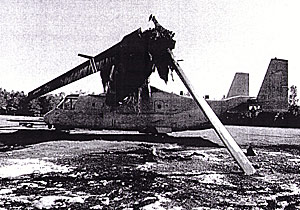 The pilot pushed the computer reset button several times, implying it was
a software failure. It seems more likely the computer was struggling to fly the aircraft as it rapidly lost
hydraulic pressure.
That is another drawback of the V-22's lightweight 5000 psi system; the hydraulic fluid leaks
out twice as fast as traditional 3000 psi systems. A hydraulic fire
ignited the composite nacelle and ruined a V-22 in Dec. 2007. (left) It was
scrapped.
The pilot pushed the computer reset button several times, implying it was
a software failure. It seems more likely the computer was struggling to fly the aircraft as it rapidly lost
hydraulic pressure.
That is another drawback of the V-22's lightweight 5000 psi system; the hydraulic fluid leaks
out twice as fast as traditional 3000 psi systems. A hydraulic fire
ignited the composite nacelle and ruined a V-22 in Dec. 2007. (left) It was
scrapped.
The program will never admit to this, but a single hydraulic failure may have caused a V-22 to crash in Dec. 2000, and will cause others to crash since leaks from any of the 24 common lines cannot be isolated. If the pilots are near the ground and react quickly, they should be able to set down before all the hydraulic fluid is gone. In addition, hydraulic fluid at 5000 psi doesn't leak in droplets, it sprays out in a mist where it mixes with air can catch fire. While hydraulic failures occur in helicopters, it doesn't cause fires or make them roll over and crash head first into the ground.
Lack of Autorotative Capability
This issue is discussed in detail in the confidential IDA study noted at the top of this article. Here is video of a basic autorotation from youtube:http://www.youtube.com/watch?v=8OXM6dJOzC4&mode=related&search=
The FAA requires helicopters to demonstrate autorotation at max gross weight (i.e. full of fuel and at max. payload.) Here is the new S-92 (an extra big Blackhawk) performing this maneuver for the FAA. It is half the size of a V-22, yet can carry twice the payload further than a V-22.
http://www.youtube.com/watch?v=4JqmoWAhv5g
They really have to pitch the nose up at
max gross weight. The engines are running but at idle
for this test, providing no power. These are test
pilots and they have a runway and nice weather, and land
at 5 knots, but remember, this is at max gross weight, i.e. twice empty weight.
Helicopter pilots often practice
autorotation, but not near max gross weight.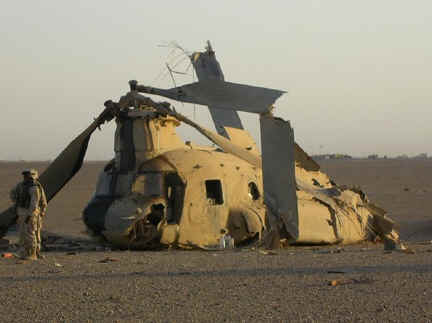
A V-22 cannot perform this maneuver, something the program admits and the OPEVAL confirmed. If an airplane loses engine power, pilots usually have several minutes to attempt to restart the engines as they glide for miles to land on a runway or open area. Helicopters have large rotors with low disk loadings that allow safe, controlled descents in autorotation, then pilots can pitch up at the last second to land smoothly. This is a safe maneuver in a helicopter and has save many lives.
Boeing claims this is not important because they estimate the chance of two modern engines failing at the same time are one in a billion flight hours. However, in 2005 a Boeing CH-47D lost both engines in Iraq. It suffered a hard landing (above), probably because it was flying low and hadn't much altitude for a full autorotative landing. The crew suffered minor injuries, but they would have died in a V-22.
A Fair Weather Aircraft
The V-22 avoided fatal mishaps during its first year in operational service by flying like an airplane from airbase to airbase. In rare cases where it operated like a helicopter, it carried little payload and flew only in good weather. This is possible because the Marines still have most of their CH-46Es to fly helicopter missions. Mishaps data for incidents are hidden since the Marine Corps no longer releases reports about V-22 accidents, unless required because of FOIA request. Yet these cannot occur unless mishaps are leaked. Bob Cox of the "Fort Worth Star-Telegram" learned of a serious V-22 fire last year only because he saw a small story about a Marine hospitalized for smoke inhalation related to a V-22 fire.
Mishap information was once posted on-line at the Navy Safety Center for all to see. This provided aircrews and maintainers with instant information about causes of recent accidents. Since critics used this data to argue that the V-22 was problematic, pressure was put on the Navy to restrict access to officers. As the CH-46Es are retired and V-22s are called upon to fly helicopter missions, mishaps will rise sharply because of four unique flaws:
Pitch-Up With Side-Slip (PUWSS) is a problem unique to the V-22. As the rotors tilt upward to the hover mode or transition to the airplane mode, the V-22's strong downwash suddenly blasts its tail appendage, causing the nose to rise sharply and the aircraft to slip toward one side. Test pilots found this disturbing, so flight control software automatically dips the nose when this occurs. This works well in still-air, but high winds or maneuvering during the PUWSS computer auto-correction phase is dangerous.
The second problem is the side-by-side rotor design adds complexity since the computer must keep the rotor thrust perfectly balanced to avoid a snap roll. As helicopters fly lower and their rotor downwash hits the ground, it begins to form an air cushion, like a hovercraft. This is called Hover-In-Ground Effect (HIGE). As a V-22 flies lower, one rotor may encounter a building or the deck of ship and enter HIGE, while the other rotor remains in Hover-Out-of-Ground-Effect (HOGE). The computer must automatically correct for this imbalance.
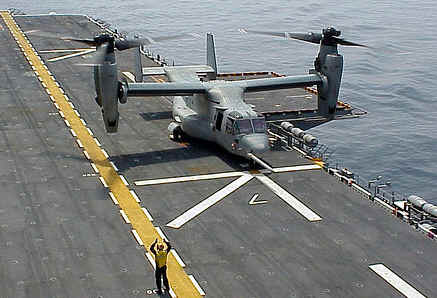 A third problem is the V-22's boxy fuselage, which provides
more internal volume than older cylindrical shapes, although 25% less than the
CH-46E. However, this allows high
winds to push it sideways, a situation made worse by the large side profile of
the engines and tail. This makes hover operations in high winds dangerous as the V-22 wants to "weathervane" and turn. A V-22 requires
up to 80% more power to hover in high winds, and if extra power is not
available because it is loaded with payload, control may be lost. A 2005 NASA
study (pdf) provides details on this problem.
A third problem is the V-22's boxy fuselage, which provides
more internal volume than older cylindrical shapes, although 25% less than the
CH-46E. However, this allows high
winds to push it sideways, a situation made worse by the large side profile of
the engines and tail. This makes hover operations in high winds dangerous as the V-22 wants to "weathervane" and turn. A V-22 requires
up to 80% more power to hover in high winds, and if extra power is not
available because it is loaded with payload, control may be lost. A 2005 NASA
study (pdf) provides details on this problem.
This is particularly problematic on ships where a V-22 must land on an exact spot on decks that normally have strong winds and odd airflows off the island and hull, plus the HIGE/HOGE problem unique to a V-22 landing on ship. Since the V-22's side-by-side rotors are several feet wider than even the huge CH-53E, it must land just five feet from the edge of the deck, with one rotor in HIGE and other in HOGE. (above) With a heavy engine already overhanging the deck, high winds and a rolling deck may cause a V-22 to tumble off the side of a ship! This is one reason why V-22s are deployed to big airbases in Iraq, and not aboard ships as part of naval task forces. A bigger problem is its hot jet exhaust blows directly downwards, causing the metal deck to warp and searing all who come near. This unsolvable problem has been known since shipboard tests in 1999.
The fourth problem is that the downwash or the wake from nearby V-22s and helicopters can cause more lift to occur on one rotor than the other, causing a snap roll. Downwash from other aircraft can impinge on one wing, causing it to dip down and bang the engine on deck, even while parked, as described in this internal NAVAIR report (pdf). This is why one never sees V-22s flying in the hover mode in close formation. NATOPS requires a 250ft. separation between V-22s to avoid VRS, which can cause a V-22 to instantly snap roll.
Standard Marine Corps helicopter assault tactics land six CH-46Es in a football field sized LZ, yet only two V-22s can safely land in that size LZ at the same time. Here is a video clip of V-22s attempting an assault landing. They must select a hard surface LZ, lest their heavy downwash clog their engine filters. They must land very slowly to avoid VRS. They can get three in the LZ if one lands first, as this video clip demonstrates. http://www.youtube.com/watch?v=n1oekSObO3I This also dispels the myth that V-22s can land in an LZ faster than helicopters.
These four issues combined with the inherent instability of the tiltrotor and other issues like VRS, bad weather, unexpected wind gusts, and minor pilot error can overwhelm the flight control computer. This already happens in less complex environments, causing a temporary loss of control. This is no problem unless an aircraft is close the ground, like with the B-2 in Guam. However, a V-22 is likely to encounter such conditions attempting to land or take-off near the ground, and given its high sink rate and tendency to snap roll, its flight control computer may not have a couple of seconds to stabilize the aircraft before it rolls over.
The Tiltrotor Lobby
V-22 has become an entity unto itself despite engineering common sense. It has demonstrated less than half the payload and range promised, and costs twice as much as promised. All major military programs have problems and suffer from cost growth, but most eventually produce something effective. The V-22 was the Marine Corps' first major procurement program, and Generals didn't know what to do when the project failed. Bell-Boeing knew what to do; get the lemon into production with the promise to fix things later. This strategy is described here: http://www.d-n-i.net/fcs/comments/c401.htm and summarized in this paragraph:
"If operational testing reveals problems, these pre-existing connections introduce political conflicts, economic rigidities, and technical constraints that make it much more difficult and costly and time consuming to change course or iterate with a major redesign. More importantly, cancellation becomes almost impossible, because the EMD and LRIP [production] decisions permitted the contractor to build a powerful political safety net by (1) hiring large numbers of production workers (2) building a nationwide network of subcontractors, and (3) setting up well-greased early warning net of lobbyists to ensure affected politicians know immediately when contracts or profits in home districts are threatened."
This succeeded in keeping the failed V-22 in production, along with the legal corruption that allows defense contractors to pay kickbacks to helpful Generals, and an unprofessional culture throughout the U.S. military in which covering up failures is commendable. This rush to production game continues today. For example, the new F-35 (JSF) fighter was approved for production after completing just 3% of its testing.
V-22 Contractors
Alabama
PPG Industries; SCI Technology
Arizona
BAE Systems (Simula); Honeywell; Sargent Controls
Arkansas
Labarge Electronics
California
Arrowhead Products; BAE Systems Composites; Eaton Aerospace; EDO;
Connecticut
Fenn; Hamilton Sundstrand; HTD Aerospace Inc.; Purdy; Times Microwave
Florida
Conax; Honeywell; L-3 Communications; Pall Aeropower Corp.; Shaw Aero Devices Inc.
Georgia
Barcoview; EFC; Engineered Fabrics; Vought Aircraft
Illinois
CEF Industries Inc.; Guardian Electric Mfg. Co.; Hamilton Sundstrand; MPC Products Corp.; SKF Aerospace; Smiths Aerospace
While the V-22 was reviewed for
cancellation in 2001, there was heavy political lobbying
to save it. The Boeing effort was
led by General Richard Hearny, the former head of Marine Aviation, who
retired in 1996 and was Vice President for business development at Boeing.
The lobby effort  for
Boeing's partner, Bell Helicopter, was led by its Vice President for
government relations, General Terrence R. Dake, who retired from the
Marines in 2000 after heading Marine Aviation. The effort at Headquarters
Marine Corps was led by the head of Marine Aviation, General Fred McCorkle
(right). for
Boeing's partner, Bell Helicopter, was led by its Vice President for
government relations, General Terrence R. Dake, who retired from the
Marines in 2000 after heading Marine Aviation. The effort at Headquarters
Marine Corps was led by the head of Marine Aviation, General Fred McCorkle
(right).
Soon after retiring from the Marines in October 2001, McCorkle joined the board of directors and as a senior advisor for GKN Aerospace Services (V-22 fuel tanks). He also serves on the Rolls-Royce North America board of directors (V-22 engines), and is a member of the board of directors of Lord Corporation (V-22 components). In addition, he has served as a consultant for Boeing Aerospace (V-22 maker) and Optical Air Data Systems (V-22 low airspeed indicator). While these Generals receive an $8000 a month retirement check from the Marines, a tradition emerged in which the head of Marine Aviation is financially rewarded after retirement for not rocking the boat. General Clay Comfort said that his older generation of retired Generals consider this practice despicable. |
Iowa
Carleton Life Support; Fansteel Wellman Dynamics
Kansas
Globe Engineering Co.; Plastic Fab
Kentucky
Foam Design
Maryland
Lockheed-Martin; Harvard Custom Mfg.; Middle River
Michigan
Eaton Aerospace
Minnesota
BF Goodrich Aerospace; General Dynamics; Rosemount Aerospace Inc.
Mississippi
Eaton Aerospace
Nebraska
GD Armament; Lincoln Composites
New Hampshire
Goodrich Corp.; Luminescent Systems Inc.; New Hampshire Ball Bearing; Smiths Tubular
New Jersey
ITT Avionics
New Mexico
Honeywell
New York
Arkwin Industries Inc.; BAE Systems; B&R Machine; GE Aviation/Smiths Aerospace; GenMech Aerospace; Goodrich Corp.; MRC Bearings; Moog Inc.
North Carolina
Curtiss Wright; Triumph Frisby
Ohio
Rolls-Royce NA.; Crane Co. GE Aviation/Smiths Aerospace; Goodrich Corp.; Honeywell; Parker Hannifin Corp.; Projects Unlimited
Oklahoma
Limco Airepair; Walden’s Machine
Oregon
Onboard Systems Inc.
Pennsylvania
Boeing; Hexcel Corp.; Lord Corp.; Olympic Tool; Triumph Controls Inc;
South Carolina
Woven Electronics
Texas
Bell-Textron; Chelton Inc.; EFW Inc.; Fore Machine; Harris Composites; Labinal; Merritt Tool Co.; Parker Hannifin; Raytheon; Vought Aircraft
Utah
Triumph Gear System
Vermont
Timken
Virginia
Howmet Hampton Casting; Moog Components; Optical Air Data Systems
Washington
Aeroject; Astronics; Crane Aerospace – E Idec; Exotic Metals Forming; GE Aviation/Smiths Aerospace
Wisconsin
Spincraft
Canada
Donlee Precision; Messier Dowty; Hispano-Suiza Electronics;
France
ECE; Artus SAS
Germany
Goodrich; Hella Lighting Systems
Great Britain
GE Aviation; GKN Aerospace Transparency; GKN Aerospace Services; Meggitt Avionics; Senior Aerospace BWT; Goodrich Actuation Systems; Flight Refueling Ltd.
_________________________________________
The V-22 cash machine is spread among 43 states and 4 foreign countries as a jobs program to ensure solid political support. Some may wonder how such a racket survives public scrutiny. Stephen McClellan's book about the financial industry "Full of Bull" provides an overview of executive traits. He writes about the "good ole boy" style used by those hiding corporate failures, like the Bell-Boeing V-22 program, which often uses senior Marine Corps officers as their "good ole boy" spokesmen. They sweet talk reporters and government investigators, buy them lunch at the club, and take them for a ride in a V-22. McClellan wrote:
"Such sweet talkers have a good sense of humor and are entertaining. They are fun to be with for golf, wine, football, and other events, but this is a form of selling for them. Good ole boys do not appreciate intense scrutiny or analytical skepticism. They usually dodge penetrating questions with a funny story or humorous quip. Their attitude is 'trust me.'
The curious thing is they believe their own blarney. Their press releases are stuffed with adjectives such as leading, enhanced, unique, significant, integrated, powerful, innovative, advanced, high-performance, and sophisticated. They talk lingo like mission-critical, strategic focus, go-forward plan, proactive, goal oriented, and all the other commendatory buzz words. This management style is evangelistic. They never stop trying to convert the heathen."
Carlton Meyer
©2008 www.G2mil.com